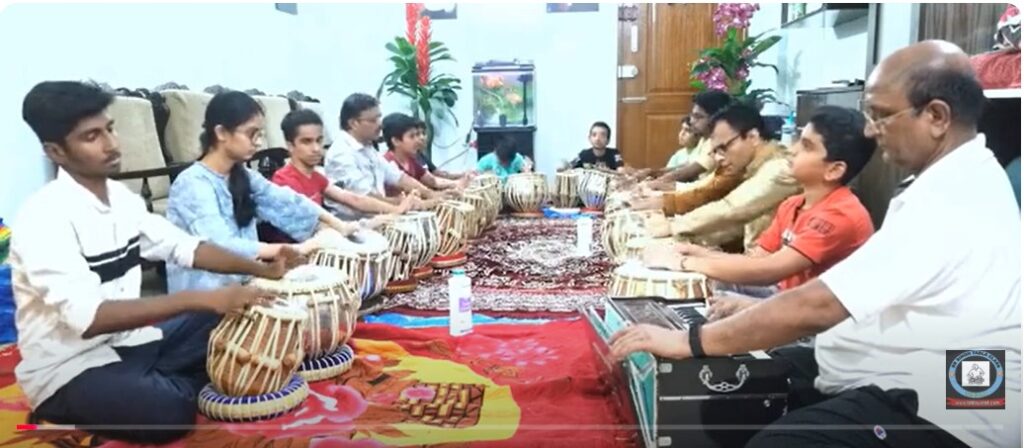Introduction
Echoes of Emotion: Visharad–1 Bhav Sangeet (Vocal & Instrumental) Echoes of Emotion: Visharad–1 Bhav Sangeet (Vocal & Instrumental) Music has always been more than mere sound—it is an echo of human emotion. In Indian classical traditions, Bhav Sangeet (expressive music) holds a special place because it captures the entire spectrum of human feelings: joy, devotion, sorrow, love, and longing. The Visharad–1 level of Bhav Sangeet (Vocal & Instrumental) introduces students and listeners to this beautiful interplay of emotion and technique. Aptly titled “Echoes of Emotion”, this journey reveals how both positive and negative moods can be expressed through music, reminding us that sound is not only heard but also felt.


Historical Roots of Bhav Sangeet
Bhav Sangeet has its origins in devotional and semi-classical traditions of Indian music. Unlike the more technical Khayal or Dhrupad, Bhav Sangeet emphasizes bhava (expression, emotion). Early saints and poets like Mirabai, Surdas, Tulsidas, and Kabir wrote compositions that continue to be sung in Bhav Sangeet style. Over time, the tradition expanded to encompass not just vocal expressions but also instrumental interpretations.
A fascinating anecdote: in the courts of medieval India, when musicians sang bhajans or thumris with intense emotional depth, it is said that even the kings were moved to tears. This is the power of Bhav Sangeet—it bridges the gap between performer and listener through shared emotion.
The Dual Faces of Emotion
One of the most beautiful aspects of Visharad–1 Bhav Sangeet is the recognition of positive and negative emotions in music.
- Positive Emotions: These are expressed through devotional songs (bhajans), joyful compositions, or romantic pieces full of optimism. For example, a bhajan in praise of Lord Krishna or a playful thumri celebrating love and togetherness. The mood is uplifting, serene, and blissful.
- Negative Emotions: Equally important are songs that explore sorrow, separation (viraha), or deep longing. These compositions may sound melancholic, but they carry immense beauty because they mirror the struggles of human life. A poignant dadra expressing heartbreak or a slow, yearning instrumental melody on the sitar accompanied by tabla highlights this side of Bhav Sangeet.
Together, they show us that music is not only about celebration—it is also about acceptance and expression of life’s challenges.
Vocal & Instrumental Dimensions
Bhav Sangeet is not confined to singing alone. At the Visharad–1 level, both vocalists and instrumentalists are trained to capture emotion.
- Vocal Bhav Sangeet: Focuses on voice modulation, lyrical interpretation, and emotional delivery. A singer must go beyond technical correctness to truly embody the feeling of the words. For instance, when singing Mirabai’s devotional bhajans, the voice must radiate surrender and devotion.
- Instrumental Bhav Sangeet: Instruments such as sitar, sarangi, flute, or violin become the singer’s voice. Even without words, the nuances of meend (glides), gamak (oscillations), and slow elaborations convey emotions powerfully. The tabla provides rhythmic grounding, amplifying joy or sorrow depending on the taal.
Rhythms and Taals in Bhav Sangeet
Emotion in Bhav Sangeet is deeply connected to rhythm. While Khayal or Dhrupad may explore complex rhythmic structures, Bhav Sangeet usually uses accessible taals such as Dadra (6 beats), Keherva (8 beats), and Deepchandi (14 beats).
- Dadra is often used for lighter, romantic or sad pieces.
- Keherva is common in devotional and folk songs.
- Deepchandi provides a dramatic, slower rhythm for more serious moods.
By choosing the right taal, the artist sets the stage for the emotion to unfold.
Famous Examples and Inspirations
Many legendary artists have enriched Bhav Sangeet with unforgettable performances:
- Pt. Bhimsen Joshi moved audiences with devotional bhajans.
- Begum Akhtar and Shobha Gurtu popularized emotional thumris and ghazals.
- Pt. Ravi Shankar’s sitar and Ustad Bismillah Khan’s shehnai often carried the emotive essence of Bhav Sangeet to the world.
In contemporary music, film songs often borrow from Bhav Sangeet traditions. Songs like “Mohe Rang Do Laal” (from Bajirao Mastani) or “Piya Tose Naina Laage Re” (from Guide) are rooted in expressive classical styles.
Cultural Relevance Today
In today’s fast-paced world, Bhav Sangeet offers a meditative pause. It reminds us that emotions—whether joyful or sorrowful—are universal and timeless. The Visharad–1 curriculum not only teaches music but also empathy, as students learn to feel before they perform. Globally, Bhav Sangeet is gaining recognition among world music enthusiasts who are drawn to its depth and authenticity.
A striking statistic: according to the Sangeet Natak Akademi, more than 30% of students enrolling in Hindustani classical music courses in India today choose semi-classical forms like Bhav Sangeet, showing its growing popularity.
Interactive Reflection
To make this learning journey engaging, here’s a quick quiz:
Q: Which taal is commonly used for romantic or melancholic Bhav Sangeet compositions?
a) Teentaal
b) Dadra
c) Jhaptaal
(Answer: b – Dadra)
👉 Poll for you: Which emotion moves you more in Bhav Sangeet?
- Devotional joy
- Romantic longing
- Melancholic sorrow
Conclusion
The Visharad–1 Bhav Sangeet journey is not just about scales, notes, or rhythms—it is about connecting with the echoes of human emotion. Whether sung or played on an instrument, it allows us to express the full range of life’s experiences, from blissful devotion to heart-wrenching separation.
As we explore Echoes of Emotion, we realize that music’s true power lies not in perfection but in its ability to touch hearts. So the next time you listen to or practice Bhav Sangeet, ask yourself: What emotion is my music carrying today?
https://www.facebook.com/sbsinghtablaguru
https://www.youtube.com/@BhagawanSingh

